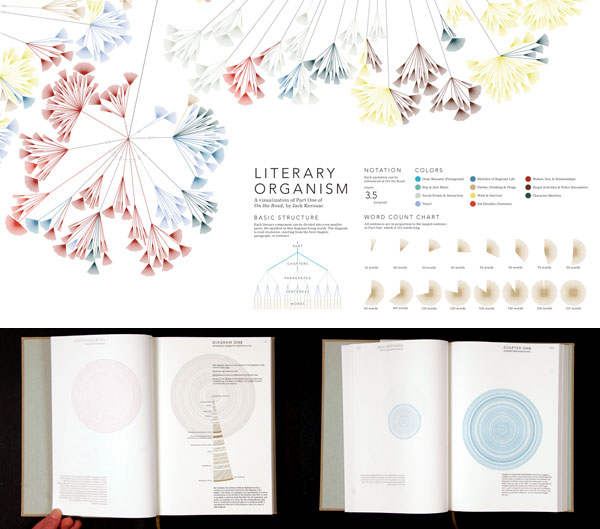
The structure of Part One of On the Road visualised using a simple tree structure that has been worked with manually in order to give it a more organic feel. Here, Part One divides into chapters, chapters divide into paragraphs, paragraphs divide into sentences, and sentences divide into words. Everything is colour-coded according to key themes in On the Road. By Stefanie Posavec, http://www.itsbeenreal.co.uk/index.php?/wwwords/literary-organism/
In occasion of the debate: «Des manuscrits antiques à l’ère digitale. Lectures et littératies» held in Lausanne, Frédéric Kaplan, a researcher in artificial intelligence, presented a series of interesting reflections around the future developments of the book’s form.
He started introducing the concept of “regulated representation”, a representation «governed by a set of production and usage rules»1. According to Kaplan, regulated representations get more regular over time, implying the transformation of a convention into a mechanism and eventually the representation becomes a machine.
That’s what happened to maps for instance: a series of convention was set during a long time span and parallel the methodologies for gathering and storing information were authomatized. The next step –made possible by digital techonologies– was the inclusion of usage convention in the map itself: tools like rotating, zooming and so on. This process of mechanization determined a sort of aggregation: «As regulated representations get more regular, they tend to aggregate into unified systems»2.
The book is a regulated representation as well, in fact if we look at scholarly books we can recognise some standard structures like index, footnotes, colophon, etc. Kaplan notices that the book has a pretty architetural function, which is to «organize a discourse in space». The book should be considered «as a closed space which can be internally organized, like a house, a small garden, a church, a theater stage»3.
Kaplan provides two different scenarios concering the future developments of the book. These are defined by two opposite techonologies. The first one is the book’s original one, which is to isolate, to structure a discourse within some determined borders. The second one belongs to the Encyclopedia ideology, which is to encompass all the human knowledge, in a open and continuative process.
The Book offers specific paths, guided tours. The Encyclopedia offers a small-scale model of the world. Book writing is about learning to finish. Encyclopedia writing is an ever-going activity aiming at continuous improvement. 4
Currently the dominant model is the encyclopedic one. It shapes the world wide web and transforms every linear content into a database. The encyclopedic turn of the book’s form has some advantages: new browsing and scanning possibilities, social reading, etc. But it may limits any structural innovation because it should be determined at a global level. This may eventually cause a form of cultural immobility.
On the other hand, applications still allow us to conceive the book as a closed form in the digital realm. Even if they provide a great level of structural and design freedom, there are some evident limitations regarding the specificity of the softwares or the reading devices. As it happened with Cd-Rom, this limitations may imply a fast obsolescense and a modest dissemination of such artifacts.
Even if it’s too early to make a choice between the two models, Kaplan suggests to experiment with book applications because they can be considered as «laboratories for inventing new interfaces for complex discourses» 5.
Kaplan concludes remarking the significance of these developments as they will eventually affect our way to experience the world.
What is at stake in the battle between the Book and the Encyclopedia is our way of being in the world, not only our relationship to knowledge but in the long term our general thinking and memorizing skills. 6
1-6. Frédéric Kaplan – How books will become machines, 2011.


